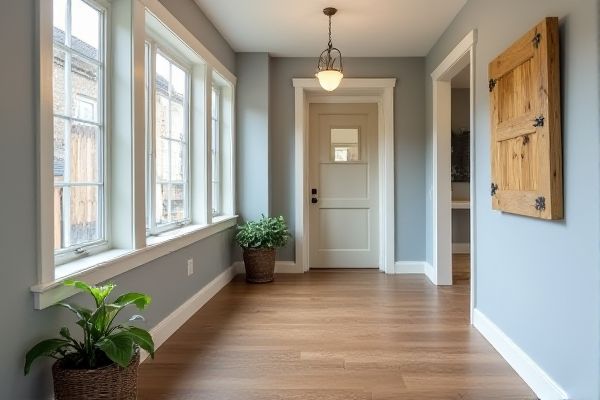
Choosing between a back mudroom and a front mudroom depends on your home's layout and daily routines, as a back mudroom typically offers a private, functional space for messy transitions, while a front mudroom provides a welcoming entryway that enhances curb appeal. Explore the advantages of each option to find the best fit for your lifestyle and home design in the rest of this article.
Table of Comparison
| Feature | Back Mudroom | Front Mudroom |
|---|---|---|
| Primary Use | Entry for dirty or wet shoes, often from backyard or garage | Welcoming entry, transitional space for guests |
| Location | Rear of the house, near backyard or garage | Front entrance of the house |
| Traffic | High for residents, low for guests | High for guests and residents |
| Design Focus | Functionality, durability, storage for outdoor gear | Style, first impression, organized storage |
| Storage | Boot trays, hooks, benches for daily outdoor use | Coat racks, shoe storage, decorative elements |
| Maintenance | Easy-to-clean surfaces, dirt-resistant materials | More decorative, possibly higher maintenance |
| Privacy | More private, used mainly by family | Less private, visually accessible to guests |
Introduction to Mudrooms: Front vs. Back
Front mudrooms serve as a welcoming entry space designed to manage outdoor elements before entering the main living area, often emphasizing aesthetic appeal and curbside convenience. Back mudrooms prioritize functionality, providing a practical transition zone for cleaning and storage after outdoor activities, typically situated near garages or yards. Your choice between a front or back mudroom hinges on the flow of your home and how you balance accessibility with the need to control dirt and clutter.
Defining the Role of Front and Back Mudrooms
Front mudrooms primarily serve as welcoming transition spaces that manage guest footwear, outerwear, and initial entry clutter, enhancing curb appeal and organization at the home's main entrance. Back mudrooms function as utilitarian hubs connecting the kitchen or garage, designed for handling daily dirt, pet gear, and laundry tasks to maintain household cleanliness. Both front and back mudrooms optimize home flow but differ in focus: front emphasizes first impressions and guest readiness, while back prioritizes practical storage and maintenance needs.
Key Benefits of a Front Mudroom
A front mudroom enhances curb appeal while providing a convenient space for guests to remove shoes and outerwear before entering the main living areas, reducing dirt and clutter. It offers organized storage for everyday items like coats, bags, and umbrellas, making daily routines smoother and more efficient. Positioned near the main entrance, a front mudroom also serves as a welcoming transition area that keeps high-traffic zones clean and orderly.
Advantages of a Back Mudroom
A back mudroom offers enhanced privacy by serving as a discreet transition zone between outdoor activities and the main living area, minimizing dirt and clutter in the entryway. It provides convenient access to laundry and kitchen spaces, streamlining the process of unloading groceries and managing household chores. This layout promotes better organization and storage solutions tailored to active family lifestyles, improving overall home functionality.
Space Utilization and Layout Differences
A back mudroom typically offers more flexible space utilization, often adjacent to the kitchen or garage, allowing for seamless storage of outdoor gear and easy access to utilities. Front mudrooms prioritize entryway aesthetics and functionality, maximizing storage in a compact footprint to manage daily comings and goings. Layout differences include a back mudroom's larger, multipurpose design for handling laundry or pet care, while front mudrooms focus on organized, visual appeal with hooks, benches, and closets near the main entrance.
Aesthetic Impact on Home Entryways
Back mudrooms offer a more discreet, functional space that keeps clutter out of your main entry, maintaining a clean and inviting front facade. Front mudrooms create a warm, welcoming aesthetic by integrating storage and seating into the primary entryway, enhancing curb appeal with stylish organization. Your choice influences the first impression visitors have, balancing practicality with design to suit your home's architectural style.
Storage Solutions: Front vs. Back Mudroom
Front mudrooms typically offer organized storage for shoes, coats, and daily essentials, creating a welcoming entry with built-in cubbies, benches, and hooks to manage clutter efficiently. Back mudrooms excel in handling more utilitarian storage needs, such as laundry baskets, pet supplies, and outdoor gear, often featuring durable materials and integrated laundry stations to keep frequently used items accessible. Both front and back mudrooms utilize customizable storage solutions, but front mudrooms emphasize aesthetics and guest readiness while back mudrooms prioritize functionality and heavy-duty organization.
Practicality for Families and Daily Use
Back mudrooms offer superior practicality for families by providing a designated space to manage outdoor gear, shoes, and backpacks away from the main living areas, reducing clutter and dirt in the home. Front mudrooms, while welcoming guests and enhancing curb appeal, often lack the functional separation needed for daily family comings and goings. For everyday use, a back mudroom serves as a practical buffer zone, streamlining routines and maintaining household organization more effectively.
Resale Value: Which Mudroom Adds More?
A front mudroom often enhances curb appeal, making it a more attractive feature for potential buyers and typically increasing resale value. Back mudrooms offer practical benefits like easy access from the garage and backyard but contribute less to the home's first impression. Homes with front mudrooms consistently report higher resale values due to their combination of functionality and aesthetic appeal.
Choosing the Right Mudroom for Your Home
Selecting the ideal mudroom location depends on your home's layout and daily routines, with back mudrooms offering direct access to the backyard and utilities, while front mudrooms provide a welcoming entry for guests. Back mudrooms often maximize practical storage for outdoor gear and laundry tasks, enhancing functionality without compromising curb appeal. Front mudrooms emphasize aesthetics and create an organized, inviting transition space that boosts home value and curb appeal.
 homyna.com
homyna.com